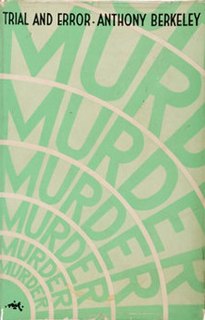
Trial and Error is a 1937 mystery detective novel by the British writer Anthony Berkeley. It was a loose sequel to the 1929 novel The Piccadilly Murder, featuring two of the characters from the earlier work the unprepossessing but shrewd Ambrose Chitterwick and Chief Inspector Moresby of Scotland Yard. Berkeley was a prominent author of the Golden Age of Detective Fiction, known for his inverted detective stories.

Not to Be Taken is a 1938 mystery detective novel by the British writer Anthony Berkeley. It was one of several stand-alone novels he wrote alongside his series featuring the private detective Roger Sheringham. It was written when the Golden Age of Detective Fiction was at its height. It was published in the United States with the alternative title A Puzzle in Poison.

The Bell of Death is a 1939 mystery detective novel by Anthony Gilbert, the pen name of British writer Lucy Beatrice Malleson. It is the sixth in her long-running series featuring the unscrupulous London lawyer and detective Arthur Crook. It was published during the Golden Age of Detective Fiction. Reviewing it for the Times Literary Supplement, Maurice Percy Ashley commented "as usual with Mr. Gilbert’s stories this is exciting and well written, but it is so complicated that the reader can do little more than hold his breath".

The Man Who Wasn't There is a 1937 mystery detective novel by Anthony Gilbert, the pen name of British writer Lucy Beatrice Malleson. It is the second in her long-running series featuring the unscrupulous London solicitor and detective Arthur Crook.
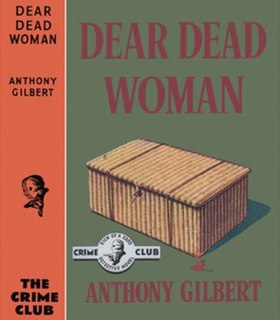
Dear Dead Woman is a 1940 mystery detective novel by Anthony Gilbert, the pen name of British writer Lucy Beatrice Malleson. It is the seventh in her long-running series featuring the unscrupulous London solicitor and detective Arthur Crook. In 1942 it was published in America under the alternative title Death Takes a Redhead.
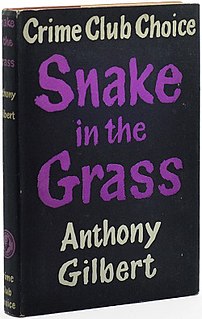
Snake in the Grass is a 1954 mystery detective novel by Anthony Gilbert, the pen name of British writer Lucy Beatrice Malleson. It is the twenty eighth in her long-running series featuring the unscrupulous solicitor and detective Arthur Crook. It was published in the United States under the alternative title Death Won't Wait. Reviewing it in the New York Times Anthony Boucher described it "one of Gilbert’s duller books", while other reviews were more praiseworthy.
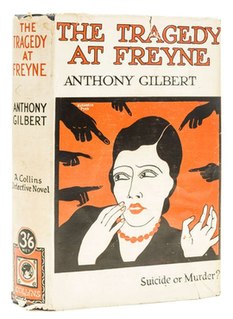
The Tragedy at Freyne is a 1927 mystery detective novel by Anthony Gilbert, the pen name of British writer Lucy Beatrice Malleson. Her first novel under the pseudonym, it introduced the amateur detective Scott Egerton who was her principle character until the creation of Arthur Crook in Murder by Experts.
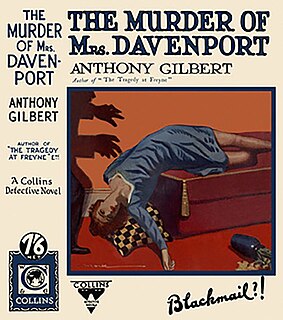
The Murder of Mrs. Davenport is a 1928 mystery detective novel by Anthony Gilbert, the pen name of British writer Lucy Beatrice Malleson. It was the second novel featuring her amateur detective Scott Egerton.

The Night of the Fog is a 1930 mystery detective novel by Anthony Gilbert, the pen name of British writer Lucy Beatrice Malleson. It is the fifth of ten novels in a series featuring her amateur detective and politician Scott Egerton, a precursor to her better known creation Arthur Crook.

The Body on the Beam is a 1932 mystery detective novel by Anthony Gilbert, the pen name of British writer Lucy Beatrice Malleson. It is the sixth of ten novels in a series featuring her amateur detective and politician Scott Egerton, a precursor to her better known creation Arthur Crook.

The Man Who Was Too Clever is a 1935 mystery detective novel by Anthony Gilbert, the pen name of British writer Lucy Beatrice Malleson. It is the tenth and last in a series of novels featuring her amateur detective and politician Scott Egerton. The following year she introduced a new character, the unscrupulous solicitor Arthur Crook, in Murder by Experts.

Don't Open the Door is a 1945 mystery thriller novel by Anthony Gilbert, the pen name of British writer Lucy Beatrice Malleson. It is the fifteenth in her long-running series featuring the unscrupulous London solicitor Arthur Crook, one of the more unorthodox detectives of the Golden Age. It was published in the United States with the alternative title Death Lifts the Latch.
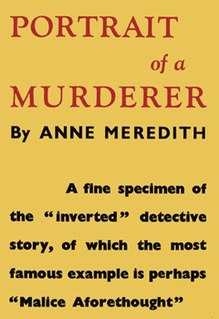
Portrait of a Murderer is a 1933 detective novel by Anne Meredith, the pen name of British writer Lucy Beatrice Malleson best known for writing as Anthony Gilbert. It was a stand-alone novel by the author at the time known for her series featuring Scott Egerton and later for her Arthur Crook mystery thrillers. It was reissued in 2017 by British Library Publishing. It broadly takes the structure of an inverted detective story, as from near the beginning the identity of the murderer is revealed.
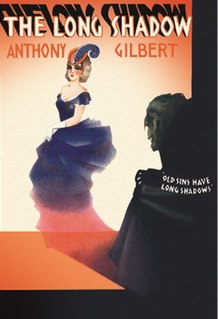
The Long Shadow is a 1932 mystery detective novel by Anthony Gilbert, the pen name of British writer Lucy Beatrice Malleson. It is the seventh of ten novels in a series featuring her amateur detective and politician Scott Egerton, a precursor to her better known creation Arthur Crook.

Death in the House is a 1939 detective novel by the British writer Anthony Berkeley. It was one of a number of stand-alone novels he wrote alongside his series featuring the private detective Roger Sheringham. It was his penultimate novel, and his final whodunnit. In later years he continued writing reviews of other crime novels, but no longer wrote his own.

As for the Woman is a 1939 novel by the British writer Anthony Berkeley, written under the pen name of Francis Iles. It was the final novel of Berkeley, a key writer of the Golden Age of Detective Fiction, as he concentrated on reviewing after this point. He later told fellow writer John Dickson Carr that he produced the book during a period of great emotional strain and that its poor commercial and critical reception affected him badly. Thereafter he turned down all offers to write further novels. Although two further novels under the Iles novels were announced by the publisher, neither of them were ever released.

Invisible Weapons is a 1938 detective novel by John Rhode, the pen name of the British writer Cecil Street. It is the twenty eighth in his long-running series of novels featuring Lancelot Priestley, a Golden Age armchair detective. A locked room mystery, the title revolves around the fact that two murders are committed by apparently invisible methods.

The Ellerby Case is a 1927 detective novel by John Rhode, the pen name of the British writer Cecil Street. It marked the third appearance of the armchair detective Lancelot Priestley, who featured in a long-running series of novels during the Golden Age of Detective Fiction. The novel's success led to a contract with Dodd Mead to release it and subsequent novels in the United States, in what proved to be a lucrative arrangement for the author.
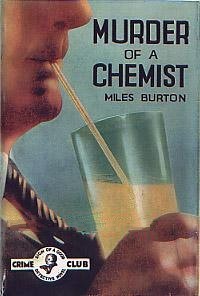
Murder of a Chemist is a 1936 detective novel by the British writer Cecil Street, writing under the pen name of Miles Burton. It is the fourteenth in a series of books featuring the Golden Age amateur detective Desmond Merrion and Inspector Arnold of Scotland Yard.

The Lake District Murder is a 1935 detective novel by the British writer John Bude. It is the first in a series of novels featuring Chief Inspector Meredith, promoted at the end of case to Superintendent. Set in the Lake District of Northern England, it shows the influence of Freeman Wills Crofts's Inspector French novels by featuring a detective who methodically breaks down the alibis of his suspects. In 2014 it was reissued by the British Library Publishing as part of a group of republished crime novels from the Golden Age of Detective Fiction.




















